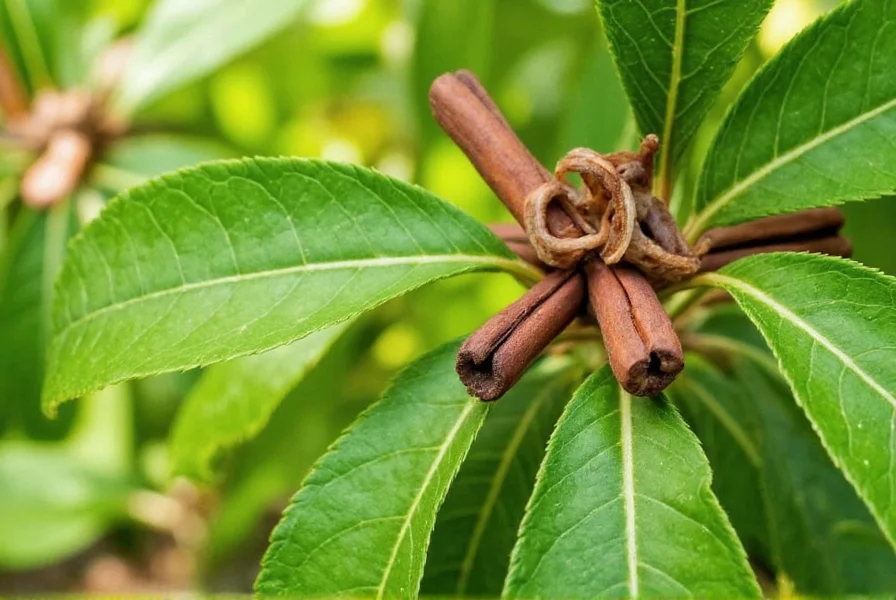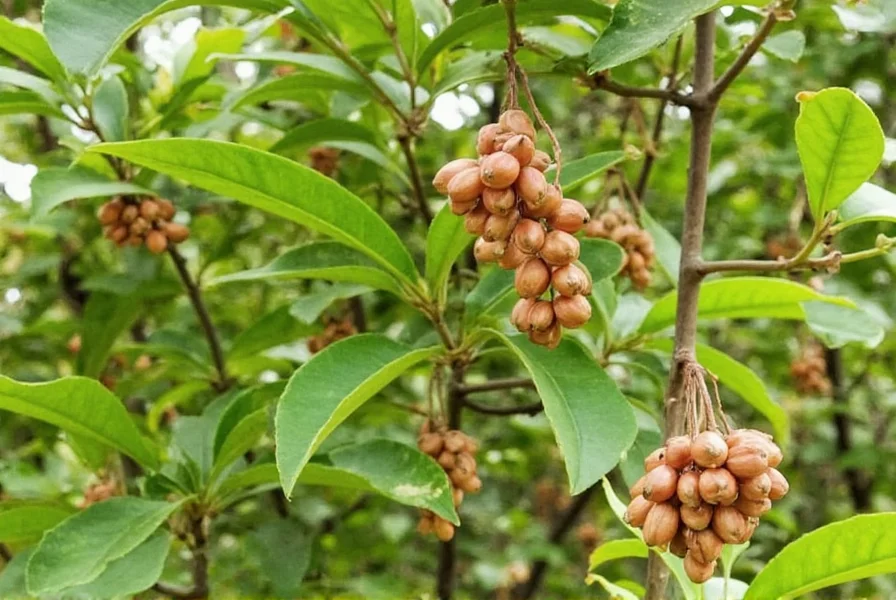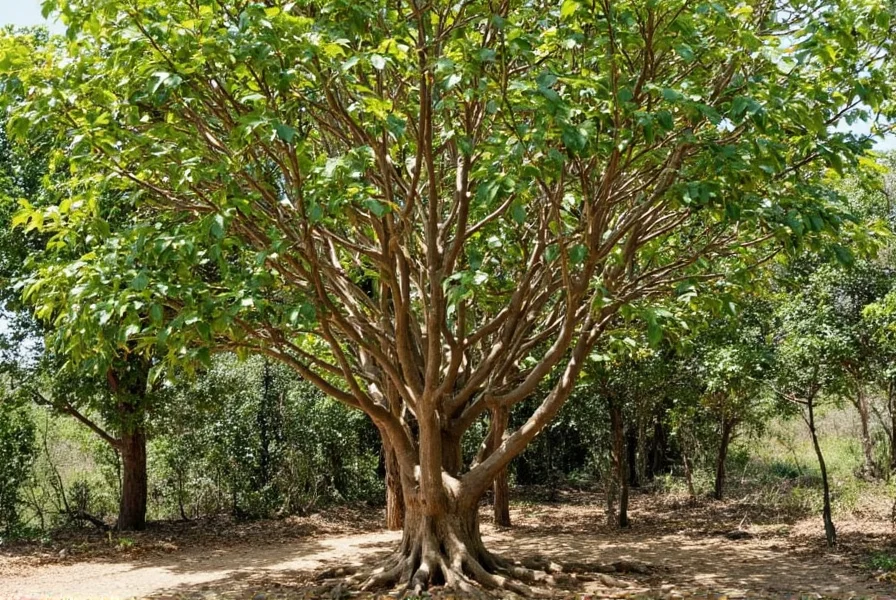For centuries, the delicate, sweet spice harvested from Cinnamomum verum has been distinguished as ‘true cinnamon’ in culinary and medicinal traditions worldwide. This botanical species produces the lighter-colored, more complex cinnamon that chefs and herbalists prize for its nuanced flavor and potential health benefits compared to the stronger, more common cassia variety.
Botanical Classification and Characteristics
Cinnamomum verum belongs to the Lauraceae family and represents the authentic source of what’s marketed as ‘true cinnamon.’ Native to Sri Lanka (formerly Ceylon), this small to medium-sized evergreen tree typically reaches 10-15 meters in height when mature. The tree features smooth, grayish bark on mature branches, while younger shoots display a distinctive green color.
True cinnamon tree leaves emerge coppery-red when young, maturing to a glossy green with a leathery texture. The leaves measure approximately 7-18 cm in length and 3-6 cm in width, featuring three prominent veins running parallel from base to tip. During flowering season, the tree produces small, white to greenish-yellow flowers in dense clusters, followed by small, dark purple berries containing a single seed.

True Cinnamon vs. Cassia: Critical Differences
Understanding the distinction between Cinnamomum verum and Cinnamomum cassia (Chinese cinnamon) is essential for both culinary applications and potential health considerations. While both belong to the same genus, they represent different species with notable variations:
| Characteristic | True Cinnamon (C. verum) | Cassia Cinnamon (C. cassia) |
|---|---|---|
| Origin | Sri Lanka, South India | China, Indonesia, Vietnam |
| Bark Structure | Multiple thin, delicate layers forming a ‘quill’ | Single thick, hard layer |
| Color | Light tan to pale brown | Dark reddish-brown |
| Taste Profile | Subtle, sweet, complex with citrus notes | Strong, spicy, slightly bitter |
| Coumarin Content | Very low (approximately 0.017 mg/g) | High (approximately 2.1-6.6 mg/g) |
These differences significantly impact both culinary applications and potential health considerations. The lower coumarin content in true cinnamon makes it preferable for regular consumption, particularly for individuals with liver concerns or those consuming cinnamon in therapeutic amounts.
Growing Requirements for True Cinnamon Trees
Cultivating authentic Cinnamomum verum requires specific environmental conditions that replicate its native tropical habitat. Successful growth depends on several key factors:
- Climate: True cinnamon trees thrive in tropical climates with temperatures between 20-30°C (68-86°F). They cannot tolerate frost and require high humidity levels (70% or higher).
- Soil: Well-draining, sandy loam soil with a pH between 5.5 and 6.5 works best. The trees prefer soil rich in organic matter but cannot tolerate waterlogged conditions.
- Water: Consistent moisture is essential, with approximately 1500-2500 mm of annual rainfall distributed throughout the year. Established trees can withstand brief dry periods.
- Light: While young trees benefit from partial shade, mature cinnamon trees require full sun for optimal growth and bark development.
Commercial cultivation typically involves planting seeds or cuttings in nursery beds before transplanting to permanent locations. Trees begin producing harvestable bark at 2-3 years of age, with peak production occurring between 6-10 years. Sustainable harvesting practices involve cutting stems close to the ground and allowing new shoots to regenerate from the stump, creating a continuous production cycle.
Harvesting and Processing True Cinnamon
The distinctive quills of Ceylon cinnamon result from a meticulous harvesting and processing technique perfected over generations. Harvesters select two to three-year-old shoots early in the morning when the bark is most pliable. Using specialized tools, they make precise longitudinal cuts through the outer bark before carefully separating the inner bark layer.
Skilled workers then peel the inner bark in long strips, which naturally curl into the characteristic ‘quills’ as they dry. Multiple thin layers are nested within each other to form the final product. This labor-intensive process contrasts with cassia cinnamon production, where thicker bark pieces are rolled into single-layer sticks.

Economic and Cultural Significance
Sri Lanka remains the world’s primary producer of true cinnamon, accounting for approximately 80-90% of global Ceylon cinnamon production. The spice holds significant cultural importance in Sri Lankan tradition, with cinnamon cultivation dating back over 2,000 years. Unlike cassia, which dominates the global market due to easier cultivation and lower production costs, true cinnamon commands premium pricing due to its more labor-intensive harvesting process and distinctive flavor profile.
Recent research has increased interest in Cinnamomum verum for potential health applications, particularly regarding blood sugar regulation and antioxidant properties. However, consumers should note that most scientific studies on cinnamon’s health benefits have used cassia varieties, which contain higher levels of bioactive compounds but also higher coumarin content.
Practical Considerations for Consumers and Growers
When purchasing cinnamon, consumers seeking authentic Ceylon cinnamon should look for specific labeling that identifies Cinnamomum verum or ‘Ceylon cinnamon.’ Many products simply labeled ‘cinnamon’ contain cassia, which is more widely available and less expensive. The distinctive layered structure of Ceylon cinnamon quills provides a visual identifier – true cinnamon forms multiple thin concentric layers, while cassia typically appears as a single thick layer.
For those interested in growing true cinnamon trees outside their native habitat, container cultivation offers the most viable option in non-tropical regions. Potted trees require protection from temperatures below 15°C (59°F) and benefit from regular misting to maintain humidity. While fruiting may be limited outside tropical zones, the trees can still produce harvestable bark under proper care.
What makes cinnamon ‘true cinnamon’ rather than cassia?
True cinnamon comes specifically from the Cinnamomum verum tree native to Sri Lanka, while most cinnamon sold globally is actually cassia (Cinnamomum cassia) from China. True cinnamon has multiple thin bark layers forming delicate quills, a lighter color, sweeter flavor, and significantly lower coumarin content compared to the single thick layer, darker color, and stronger flavor of cassia.
Can I grow a true cinnamon tree in a temperate climate?
True cinnamon trees require tropical conditions to thrive outdoors. In temperate climates, they can be grown in containers indoors where temperatures stay above 15°C (59°F) year-round. Container-grown trees need high humidity (70%+), bright indirect light, and consistently moist but well-draining soil. While they may not reach full size or produce abundant harvestable bark, they can still grow as attractive houseplants.
Why is true cinnamon more expensive than regular cinnamon?
True cinnamon commands higher prices due to its more labor-intensive harvesting process (requiring skilled workers to peel multiple thin bark layers), lower yield per tree, and limited growing regions primarily restricted to Sri Lanka. The production process for Ceylon cinnamon takes approximately three times longer than cassia cinnamon, and the delicate quills require more careful handling and packaging.
How can I identify true cinnamon when shopping?
Look for specific labeling that says ‘Ceylon cinnamon’ or ‘Cinnamomum verum.’ Visually, true cinnamon forms thin, multi-layered quills that resemble cigar tubes, with a lighter tan color and brittle texture that crumbles easily when ground. Cassia cinnamon typically appears as a single thick, hard layer in a darker reddish-brown color. True cinnamon also has a sweeter, more complex aroma with citrus notes compared to cassia’s stronger, spicier scent.
Is true cinnamon healthier than cassia cinnamon?
Both types offer potential health benefits, but true cinnamon contains significantly lower levels of coumarin (a compound that can cause liver issues in high doses). While cassia has higher concentrations of certain bioactive compounds, its elevated coumarin content makes true cinnamon preferable for regular consumption, especially for individuals with liver concerns or those using cinnamon therapeutically. For occasional culinary use, either type is generally safe, but for daily consumption, true cinnamon represents a safer option.











 浙公网安备
33010002000092号
浙公网安备
33010002000092号 浙B2-20120091-4
浙B2-20120091-4